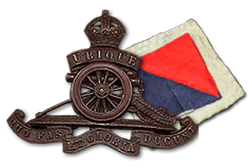
The Hull Blitz was the bombing campaign that targeted the English port city of Kingston upon Hull by the German Luftwaffe during the Second World War.

135th Field Regiment was a Royal Artillery (RA) unit being formed in Britain's part-time Territorial Army (TA) on the outbreak of World War II. Spun off from an existing unit, it took over two batteries from Hertfordshire and Northamptonshire and was later granted the double subtitle '(East Anglian) '. As part of the 18th Infantry Division the regiment remained in the United Kingdom until 1941 when it was sent to India. The division was deployed to Fortress Singapore where it was captured by the Japanese. Some of the prisoners were murdered in cold blood, many of the others died working on the Burma Railway. The regiment was never reformed.

The 79th Heavy Anti-Aircraft Regiment, Royal Artillery was an air defence unit of Britain's Territorial Army (TA). Formed just before World War II, it fought in the Battle of France, the Swansea Blitz, Operation Torch and the Italian Campaign. It continued serving in the post-war TA until 1955.

The 6th Anti-Aircraft Division was an air defence formation created within Anti-Aircraft Command of Britain's Territorial Army just before the Second World War. It defended the Thames Estuary and the approaches to London during the Battle of Britain and the Blitz.
The 37th Anti-Aircraft Brigade was an air defence formation of Britain's Territorial Army (TA) formed just before the outbreak of the Second World War. It was engaged in defending the Thames Estuary during the war, and continued to form part of Anti-Aircraft Command in the postwar era.

The 5th Anti-Aircraft Division was an air defence formation of Britain's Territorial Army, created in the period of tension before the outbreak of the Second World War. It defended Southern England during the Battle of Britain and the Blitz.

The 9th Anti-Aircraft Division was an air defence formation of the British Army during the middle years of the Second World War. It defended South Wales and the Severn Valley during The Blitz but only had a short career.

248th (Welwyn) Heavy Anti-Aircraft Battery, Royal Artillery, was an air defence unit of Britain's Territorial Army (TA). Formed just before the Second World War, it fought in the Battle of France and the Swansea Blitz, and later defended London and Cyprus. It continued serving in the post-war TA until 1955.

120th Heavy Anti-Aircraft Regiment, Royal Artillery was an air defence unit of the British Army during World War II. Raised in early 1941, it served to protect South Wales and London before proceeding overseas in 1943. It provided anti-aircraft (AA) cover over Cyprus until its disbandment in 1944.

85th (Tees) Heavy Anti-Aircraft Regiment, Royal Artillery was a part-time unit of Britain's Territorial Army (TA) formed from forces around the river Tees just before the outbreak of World War II. Its service during the war included the Battle of France and Dunkirk evacuation, the Battle of Britain and Blitz, and the North African and Italian campaigns. It continued to serve in the air defence role until 1961.
45th Anti-Aircraft Brigade was an air defence formation of Britain's Territorial Army (TA). Formed in 1938, it was responsible for protecting South Wales during the Second World War. It was reformed in the postwar TA under a new title, and continued until 1955.

The 77th Searchlight Regiment was an anti-aircraft (AA) unit of Britain's Royal Artillery (RA) formed during World War II. After serving in Anti-Aircraft Command during the Blitz it was converted into a Light Anti-Aircraft (LAA) gun unit. Although assigned to 21st Army Group for Operation Overlord, it did not go overseas and was disbanded in June 1944.

131st Heavy Anti-Aircraft Regiment was an air defence unit of Britain's Royal Artillery formed during World War II. It was organised as the first 'Mixed' regiment in which women of the Auxiliary Territorial Service were integrated into the unit's personnel, though it later reverted to an all-male organisation. It defended the United Kingdom against aerial attack for two years.

132nd (Mixed) Heavy Anti-Aircraft Regiment was an air defence unit of Britain's Royal Artillery formed during World War II. It was one of the first 'Mixed' regiments in which women of the Auxiliary Territorial Service were integrated into the unit's personnel. It defended London and South-East England against aerial attack until it deployed to Belgium in January 1945 to defend Brussels against V-1 flying bombs.

137th (Mixed) Heavy Anti-Aircraft Regiment was an air defence unit of Britain's Royal Artillery formed during World War II. It was one of the first 'Mixed' regiments in which women of the Auxiliary Territorial Service were integrated into the unit's personnel. It defended the United Kingdom against aerial attack until it deployed to Belgium in January 1945 to defend Brussels against V-1 flying bombs.

435th (Mixed) Heavy Anti-Aircraft Battery was an air defence unit of Britain's Royal Artillery formed during World War II. It was the first 'Mixed' battery in which women of the Auxiliary Territorial Service were integrated into the unit's personnel and was the forerunner of hundreds of later batteries. It defended the United Kingdom against aerial attack until it deployed to Belgium in January 1945 to defend Brussels against V-1 flying bombs.

155th (Mixed) Heavy Anti-Aircraft Regiment was an air defence unit of Britain's Royal Artillery formed during World War II. Around two-thirds of its personnel were women from the Auxiliary Territorial Service (ATS). After defending the West of Scotland and later London, the regiment was heavily engaged in Operation Diver against V-1 flying bombs, and later was deployed to Antwerp to carry out anti-Diver duties there in the closing stages of the war.

183rd (Mixed) Heavy Anti-Aircraft Regiment was an air defence unit of Britain's Royal Artillery formed during World War II. Around two-thirds of its personnel were women from the Auxiliary Territorial Service (ATS). The regiment was heavily engaged in Operation Diver, defending England against V-1 flying bombs, and later was deployed to Antwerp to carry out anti-Diver duties there in the closing stages of the war.

143rd Heavy Anti-Aircraft Regiment was an air defence unit of Britain's Royal Artillery formed during World War II. It started out as a 'Mixed' regiment with around two-thirds of its personnel being women from the Auxiliary Territorial Service (ATS). The regiment defended the West of England from 1942 to the end of the war when it moved to South East England. The regiment continued in the postwar British Army.

163rd (Mixed) Heavy Anti-Aircraft Regiment was an air defence unit of Britain's Royal Artillery formed during World War II. Around two-thirds of its personnel were women from the Auxiliary Territorial Service (ATS). The regiment defended London, operating the heaviest guns serving with Anti-Aircraft Command.








